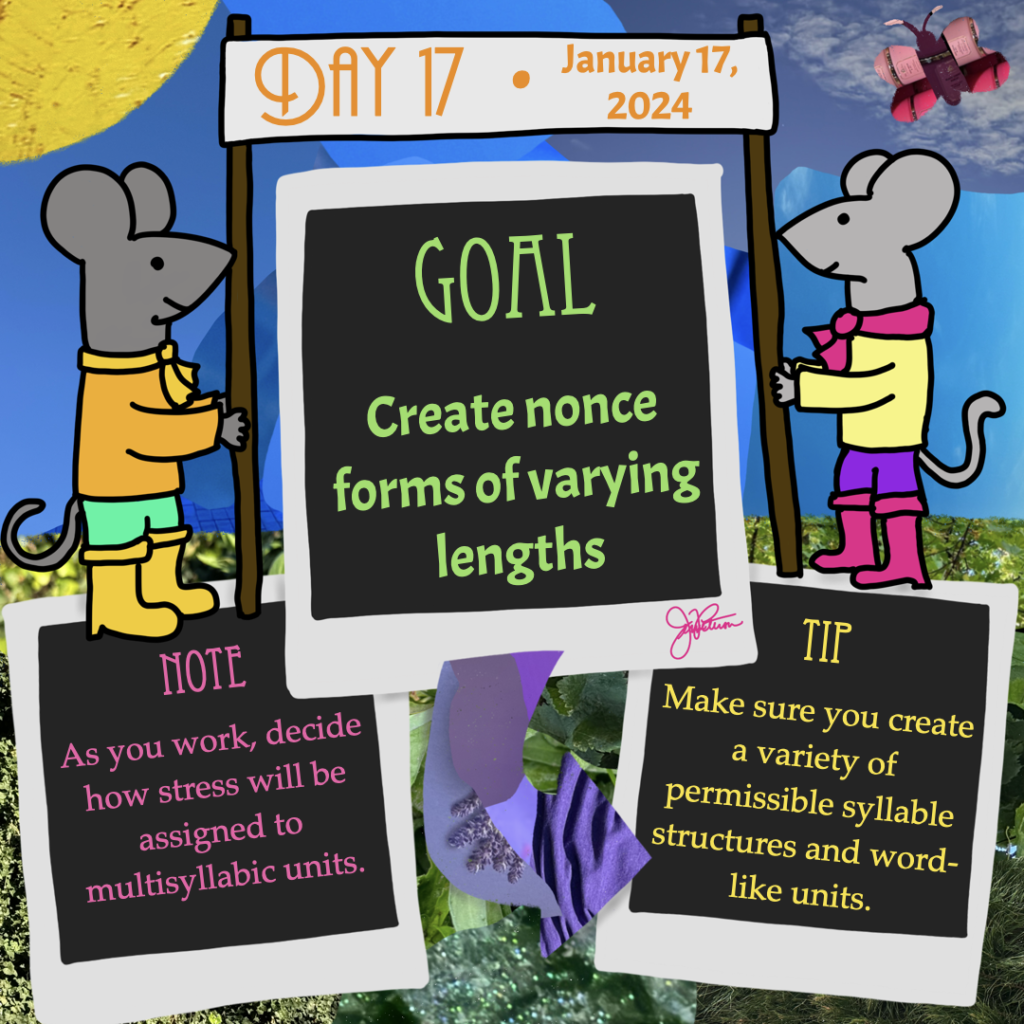
Goal: Create nonce forms of varying lengths
Note: As you work, decide how stress will be assigned to multisyllabic units.
Tip: Make sure you create a variety of permissible syllable structures and word-like units.
Work focus: Create/Make/List
Today’s focus is to put the syllable structure you selected yesterday to the test by creating nonce forms of varying lengths to make sure you like how the sounds are coming together. In this context, a nonce form means a phonologically licit form that lacks meaning. In other words, it uses the sounds you have in your inventory, and all the syllable forms within it are allowable by your system. But the form means nothing—at least not yet. If you put together forms you like, you can always save them for later when you are creating vocabulary and use them. But the focus for now is on making sure you like what happens when you get a variety of sounds and syllable structures from your system side-by-side.
To really test the system, it’s good to create nonce forms of varying lengths, from one-syllable forms to forms with three or more syllables, and varying forms, from the smallest allowable syllable structures to the most complex ones (and everything in between!). Furthermore, make sure you’re using a variety of sounds across the positions within syllables. For instance, if you allow any consonant to serve as a coda, make sure you the forms you create with coda consonants vary the type of sound occurring in that position. It’s easy to get in a “sound rut,” so to speak, and create forms that end up using the same patterns. You may take a step back and look at the forms, only to realize every single coda consonant is a [t] or every time you have a voiced stop as an onset, it is followed by the same diphthong.
Once you have a series of nonce words, test out how they feel when you read them one after the other. You may find that you want to revise your sound inventory or the syllable structure. Or you may find that you like the overall system, but there are spots where you aren’t as happy with, where certain sounds appear next to each other. Take note of those areas because they are good sources for introducing sound changes later on. For instance, if you don’t like how it sounds when a voiced stop coda is followed by a voiceless fricative onset, you can create a sound change (or series of sound changes) later on to take care of those instances.
As you work with your longer nonce forms (two or more syllables), play around with where you put the stress—or which syllable is the most prominently produced within a string of syllables. If you’re not super familiar with stress or stress options, a good place to start is to have stressed syllables that are produced with more volume, longer duration, and/or higher pitch. (Even if you want a tonal language, you can start with a proto-language that has stress and then introduce tone through sound changes.) And then you can decide if you want stress that regularly falls on the same position within longer word forms, such as selecting one of these systems (each exemplified by the same nonce form, antelizgo, with the stressed syllable appearing in all caps):
- initial stress (the first syllable receives stress): ANtelizgo
- antepenultimate stress (the third-from-last syllable in a word is stressed): anTElizgo
- penultimate stress (the second-from-last syllable is stressed): anteLIZgo
- ultimate stress (the final syllable receives the stress): antelizGO
Or you could choose to have more variable stress. Some stress systems are sensitive to syllable weight, where a light syllable is an open one and a heavy syllable is a closed one. For example, you could decide to have stress that falls on the penultimate syllable in most instances, but stress is pulled to the final syllable if it is heavy. In a word like antelizgo, the stress would fall on the [liz], which is the penultimate syllable. However, if a coda consonant were added to the end, stress would shift to the final syllable: antelizGOR.
You have a lot of options when it comes to assigning stress. If you aren’t sure what you want to do, I encourage you to research options to get inspired by what other languages do!
